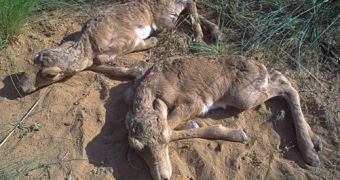Having a twin sister proves to be a huge reproductive disadvantage for males.
At least for the saiga antelopes roaming the Eurasian steppe.
A three years research found that male twins who have a sister present a lower, sub-optimal birth bodyweight than those with a brother, a trait they will display also at maturity. In mixed-sex twins, the male fetus does not experience the substantial amount of growth that occurs in a male fetus with a brother.
This is crucial, as saiga males are polygamous (mate with many females) and the strongest ones will eliminate from the reproductive cycle the weaker ones during the short mating seasons.
Thus, size is a major limiting factor for reproductive success. The precise mechanism of this phenomenon is not known, but its presence is certain. "When siblings in a litter vary in sex, maternal investment should be sex-specific, meaning that the male fetus grows bigger than the female. However, it seems there are limitations in the ability of the mother to provision mixed twin litters in the womb," said lead-author Aline K?hl from Imperial College London's Division of Biology.
Mixed-sex litters have been found to have a detrimental effect also in other species. Cattle calves from mixed litters are less fit and the female ones are generally infertile (contrary to saigas, in cows the female gender is more severely affected). "Even a relatively small decrease in birth weight is likely to have an amplified negative effect on male reproductive fitness in species where competition amongst males for mates is very high" K?hl said.
The saiga antelopes are ideal for searching the effects of mixed-sex twin litters on size and development as there is a high proportion of twin births in the population, and because the optimal birth weight for males and females of the species have very different values. The saiga females were found to be the hoofed mammals that invest most in their pregnancy, in some the calves representing 38% of their own body weight.
The investigation was made on populations living in the autonomous Republic of Kalmykia (Russia) but the researchers also used data from Soviet monitoring in the Betpak-dala saiga population (Kazakhstan).
The results were similar for both populations. The calves were weighed and measured during three May birth seasons. These antelopes give birth in mass (all females gather in a densely packed herd to give birth within a week), a phenomenon aiming to decrease the effect of predation on calves (too much calves at once ensure that only a small percentage will be eaten). This eases the monitoring of the reproductive state of the population.
Saiga have suffered a dramatic drop in numbers of over 95% in the last years, becoming one of the most critically endangered species worldwide.

 14 DAY TRIAL //
14 DAY TRIAL //